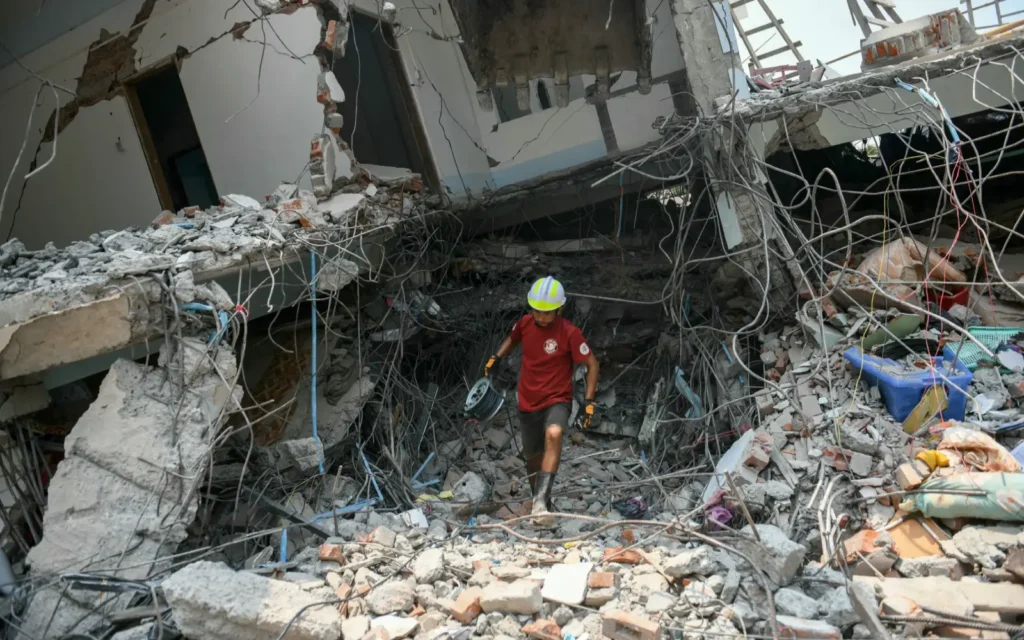Devastating Earthquake Strikes Myanmar and Thailand, Hundreds Feared Dead


Galaxy Tribune Report
Catastrophic Quake Leaves Widespread Destruction
A massive 7.7-magnitude earthquake struck Myanmar at midday on Friday, causing severe damage and loss of life across Myanmar and neighboring Thailand. Officials warn that the death toll—already surpassing 140—could rise significantly as rescue operations continue. The hardest-hit areas include Myanmar’s second-largest city, Mandalay, and the Thai capital, Bangkok, where a high-rise building under construction collapsed, leaving six dead and more than 100 missing.
Rescue teams are working tirelessly in the affected regions, pulling survivors from the rubble. Myanmar’s military leader, Senior Gen. Min Aung Hlaing, confirmed at least 144 fatalities and over 730 injuries. In Bangkok, authorities reported 22 injured individuals and revised the local death toll to six, down from an earlier count of 10, due to incorrect initial reports. Officials believe that more people may still be trapped beneath the wreckage.
Aftershocks and Structural Damage Exacerbate Crisis
The devastation worsened as powerful aftershocks followed, including one measuring 6.4 magnitude. Buildings in Mandalay, Naypyitaw, and surrounding areas collapsed, and roads cracked under the force. One of Mandalay’s largest monasteries crumbled, while reports from Naypyitaw show emergency responders digging through debris to recover trapped victims.
Myanmar sits in an active seismic zone, but previous earthquakes have often struck less populated areas. The scale of destruction in densely populated urban centers this time has heightened concerns. The U.S. Geological Survey estimates that the death toll could exceed 1,000 as authorities continue to assess the full impact.
International Community Rallies for Relief Efforts
As Myanmar and Thailand struggle to cope with the aftermath, several nations and international organizations have stepped in to provide humanitarian aid and emergency relief. China has already sent a 37-member rescue team, equipped with drones, earthquake detectors, and essential supplies. Russia has dispatched two aircraft carrying 120 emergency responders, medical equipment, and survival gear, while India has provided a search and medical team, along with food, blankets, hygiene kits, and solar lamps to assist displaced victims. The United Nations has allocated $5 million for initial relief efforts, ensuring immediate humanitarian assistance, while U.S. President Donald Trump has pledged American support. However, some experts worry that previous cuts to U.S. foreign aid could hinder large-scale disaster response efforts.
Amid rising concerns over Myanmar’s strict information controls and ongoing civil war, many humanitarian groups fear delays in delivering aid to those most in need. The destruction of roads, bridges, and communication lines has made it difficult for rescuers and supplies to reach isolated communities. While international aid pours in, relief workers are struggling to navigate the devastation to ensure that help reaches those in critical condition.
Bangkok’s Tragic Collapse Stuns Residents
In Thailand, the disaster’s most shocking moment came when a 33-story high-rise under construction crumpled in the heart of Bangkok. The collapse sent a massive cloud of dust into the air, and videos circulating online captured the chaos as bystanders screamed and ran for safety. Emergency teams worked through the night, rescuing dozens of trapped workers while more remained unaccounted for. Sirens blared across downtown Bangkok, and hospitals prepared for a surge of injuries. “It’s a great tragedy,” said Thailand’s Deputy Prime Minister Suriya Juangroongruangkit after surveying the wreckage.
Eyewitnesses described terrifying moments as buildings swayed and lights flickered. Many residents, unaccustomed to earthquakes, fled their homes and offices in panic. “I’ve never experienced anything like this in Bangkok,” said Voranoot Thirawat, a lawyer who rushed down 12 flights of stairs to escape her office.
The tremors were also felt in China’s Yunnan and Sichuan provinces, where reports indicate injuries and property damage in border towns. Authorities continue to monitor the situation as aftershocks persist.
Economic Consequences: A Blow to an Already Struggling Region
The earthquake’s devastation extends beyond human casualties—it has also dealt a severe blow to Myanmar and Thailand’s economies, both of which were already facing major challenges.
In Myanmar, the collapse of critical infrastructure has crippled transportation and logistics, particularly in major cities like Mandalay and Naypyitaw, making recovery efforts even more challenging. The disaster has also severely impacted industry, as Myanmar’s fragile economy—already struggling under sanctions and ongoing civil conflict—now faces even greater uncertainty with businesses, factories, and local markets suffering extensive damage. Furthermore, Myanmar’s tourism sector, already in decline due to political instability, is expected to take another devastating hit as potential visitors reconsider travel plans.
Thailand, though better equipped to handle natural disasters, is also facing significant economic consequences. The Bangkok high-rise collapse has shaken confidence in the city’s booming real estate and construction sectors, potentially delaying major projects. Retail and business activity has been disrupted, as major shopping districts were affected by tremors. Bangkok’s economy, which relies heavily on commercial activity and tourism, may struggle in the short term as investors and consumers grow wary. Additionally, concerns about safety could deter international travelers from visiting Thailand, dealing a blow to one of its most vital economic sectors.
As Myanmar and Thailand assess the full scale of the economic damage, international financial institutions may step in with aid and recovery loans. The Asian Development Bank (ADB) and the World Bank have yet to announce support, but experts expect emergency funding to be part of the rebuilding effort. With rescue operations still underway, both nations face a long road to recovery, balancing humanitarian needs with the economic burden of rebuilding.
Tremors Felt in China’s Yunnan and Sichuan Provinces
To the northeast, the powerful quake also shook parts of China’s Yunnan and Sichuan provinces, causing structural damage and injuries, particularly in the city of Ruili, near the Myanmar border. Chinese state media reported that the tremors were strong enough to disrupt daily life, with some buildings suffering cracks and minor collapses. In Mangshi, a city approximately 100 kilometers (60 miles) northeast of Ruili, residents described the ground shaking so violently that they were unable to stand upright. Many people fled into the streets, fearing aftershocks. Authorities in China’s border regions are assessing the full impact of the quake and providing emergency aid to affected communities.
Disclaimer
At Galaxy Tribune, we strive to verify the authenticity of every news and insight published. However, since our content comes from various sources and contributors, absolute accuracy cannot be guaranteed. Articles related to health, nutrition, food safety, and environmental concerns serve informational purposes only. Before making decisions based on these topics, readers should consult health professionals, nutritionists, or environmental experts
.Galaxy Tribune offers more than just news. It’s a space for curious minds eager to stay informed and explore fresh perspectives. Thank you for being part of this journey.






